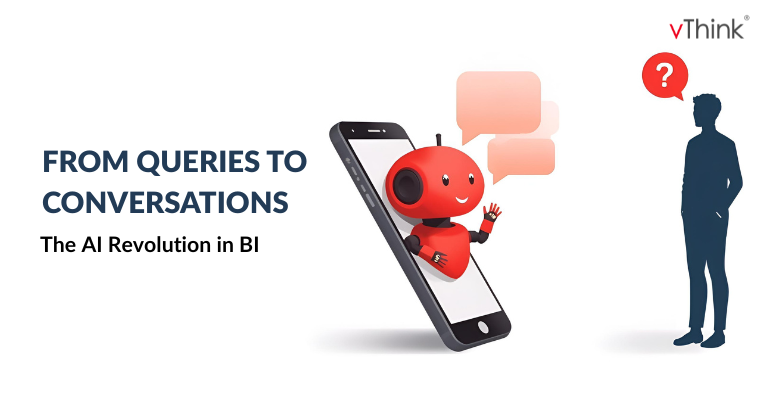From Queries to Conversations: The AI Revolution in Business Intelligence

The world of Business Intelligence (BI) is undergoing a profound transformation. Gone are the days when only those with technical expertise could access data. Today, data access is evolving into natural, conversation-driven interactions. This is more than just a technological upgrade, it is a fundamental rethink of how every part of an organization interacts with, understands and acts on data insights.
Business leaders no longer have to rely solely on data analysts for answers. Conversational BI empowers employees at every level to get insights as easily as asking “Which products performed best last quarter?” This revolution is making data accessible to everyone, turning employees into confident, data-driven decision-makers.
From Code to Conversation: The Evolution of Business Intelligence
1960s–1980s: Early Data Processing
Data was stored on mainframes, and accessing insights required highly structured reporting systems—available only to the largest corporations.
1990s–2000s: Traditional BI Takes Shape
The rise of enterprise analytics brought data warehouses, OLAP cubes, and SQL queries. BI became a complex discipline requiring specialized skills.
2010s: Opening the Door
Drag and drop platforms like Tableau and Power BI made data visualization accessible to everyday business users.
2020s: The Conversation Begins
Natural Language Processing (NLP) has transformed how we interact with data. Now, simply asking a question can deliver insights, making data truly accessible to everyone.
Every step in this journey has reduced barriers between people and insight and conversational BI represents the biggest leap yet.
The Hidden Barrier in Traditional BI: SQL
The Need for Code
Traditional BI relies on SQL. Simple questions like “Which sales rep performed best this month?” require complex queries:
SELECT s.rep_name, SUM(o.amount) as total_sales
FROM sales_reps s
JOIN orders o ON s.rep_id = o.rep_id
WHERE o.order_date >= '2025-01-01'
AND o.order_date < '2025-02-01'
GROUP BY s.rep_name
ORDER BY total_sales DESC
LIMIT 1;
This creates bottlenecks. Business users often need to submit a ticket and wait for a data analyst, delaying decisions and causing analysis paralysis, waiting days or weeks for answers to time-sensitive questions.
Why Traditional BI Holds Us Back
The SQL Barrier: Most team members don’t know SQL. Only 23% of business users can effectively write queries, leaving everyone else dependent on IT.
The Waiting Game: Waiting 3–5 business days for insights is too slow in today’s fast-moving world. By the time answers arrive, opportunities may have passed.
Wasted Licenses: Complex tools are often avoided 70% of BI licenses go unused due to steep learning curves.
No Follow-Up Questions: Static dashboards provide one answer at a time, limiting exploratory analysis and deeper insights.
Result: Restricted data access missed opportunities and stifled innovation.
The solution: Conversational BI that speaks business language, not code.
Conversational BI: Data That Speaks Your Language
Conversational BI changes everything. Ask a question in plain English and you get an immediate actionable answer, No SQL and No complicated dashboards.
Ask the Question: Type or speak naturally, Ex: “Show our revenue trend for the last six months”.
AI Understands: Smart AI translates your question into the necessary database search.
Get the Answer: Receive results, charts, summaries, or exact numbers instantly and with context.
This breaks down barriers, making analytics accessible to everyone and ensuring insights flow freely across the organization.
How AI Powers Conversational BI
Understanding Your Words (NLP)
- Detects the core intention of your question.
- Remembers previous interactions, enabling follow-ups like “Show me the same data for last year.”
Learning from Experience (Machine Learning)
- Translates simple language into database queries automatically.
- Learns from user behavior to anticipate future needs.
How It Works
- Speak or type your question.
- NLP decodes the meaning.
- AI queries the relevant data.
- Results are presented in clear visualizations.
- System improves with every interaction.
Conversational BI in Action
Retail Management: Question: “Which products are trending in west coast stores this month?” AI Response: Instant insights into top-selling items and inventory recommendations across 47 locations.
Financial Insights: Question: “Alert me if any client portfolio drops more than 15% in a day.” AI Response: Immediate alerts, clear summaries of risk, and actionable next steps.
HR Decisions: Question: “Show departments with the highest employee satisfaction scores and why.” AI Response: Detailed breakdown linking satisfaction surveys to team performance, highlighting practices to replicate.
Conversational BI moves organizations from reactive reporting to proactive intelligence.
The Conversational BI Advantage
- Faster Decisions: Immediate insights replace days of waiting.
- Data for Everyone: Empowers more users to actively engage with analytics.
- Lower Reporting Costs: Reduced reliance on specialized analysts.
- Fueling Innovation: Readily available insights drive creative, data-backed projects.
It also fosters a culture where data is part of everyday business conversation, improving forecasting, customer experience, and competitiveness.
Overcoming Challenges: Security, Trust and Integration
Data Security: Role-based access and data masking ensure sensitive information is protected.
Trustworthy Insights: Explainability, confidence scores, and source attribution make AI-generated insights reliable.
Seamless Integration: Robust APIs and data connectors bridge old and new systems.
Best Practices for Adoption
- Start small with pilot programs.
- Set governance rules for AI insights.
- Train teams to interpret data correctly.
- Keep humans in the loop for critical decisions.
- Communicate benefits, address automation concerns, and share success stories.
The Future is Conversational
- Hands-Free Interaction: Ask complex questions with voice commands.
- Personal Data Assistants: AI anticipates needs and surfaces relevant insights.
- Predictive Analytics: Insights arrive before you even ask, empowering faster decisions.
Conversational BI is more than a technological upgrade and it’s the democratization of data. Organizations adopting it now are becoming true data leaders, empowering every employee to contribute insights and drive innovation.
Conclusion: Beyond Queries
The era of static reports and manual queries is fading. With AI-powered conversational BI, anyone can interact with data using natural language, gaining insights instantly without technical expertise. This shift is not just about efficiency and it’s about enabling smarter, faster and more informed decision-making across the organization.
By moving beyond queries and embracing dialogue with data, businesses unlock the true potential of their information, fostering a culture of curiosity, agility and continuous improvement. The future of Business Intelligence is here, and it speaks.



